Welcome to my complete guide to hiking Peru’s Ausangate Trek. This is a stunning hike through the wildest and rarely visited areas in Peru. Namely, the beautiful Cordillera Vilcanota mountain range.
The route takes hikers over several high passes and down into low alpine valleys.
Discover traditional Peruvian villages, herds of llamas, glaciers, and turquoise lakes.
You will also get the chance to see the Rainbow Mountains of Vinicunca!
In this article, I’ve included a detailed overview of all route and itinerary options. There's also useful info on packing, acclimatisation, and preparation. Everything you need to ‘know before you go’ on an amazing Ausangate trek starts here.
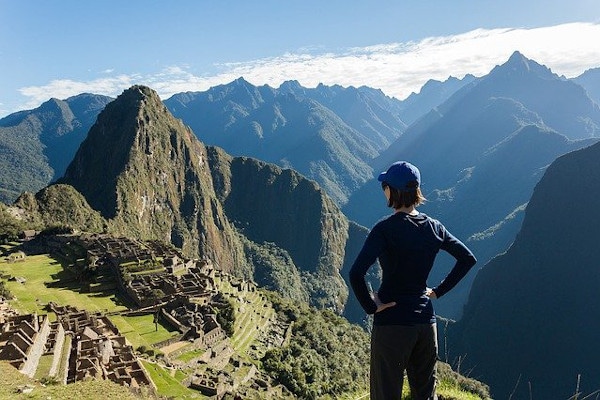
Get a Machu Picchu trek quote
Start planning your Machu Picchu hiking holiday.
Ausangate Trek – An Overview
Ausangate Trek: The Basics
Whilst most Ausangate treks are offered on a 6-day itinerary, certain companies will combine the trek with a visit to Machu Picchu as well. This adds an additional 3 days to your trip. You will also have the option of visiting the world famous Rainbow Mountains.
The trail winds 70km / 43 miles through the Vilcanota Mountain range. This is closer to 100km / 62 miles if you extend your trek to Machu Picchu (see more on this below).
You will start and end your trek at the town of Tingui (sometimes called Tinki). Unlike the Inca Trail, no permit is needed for the Ausangate trek.
The Ausangate trek is more challenging than some of the alternative Inca Trail trails to Machu Picchu. As a result, it is one of the quietest in the region. You can go days without another tourist in sight.
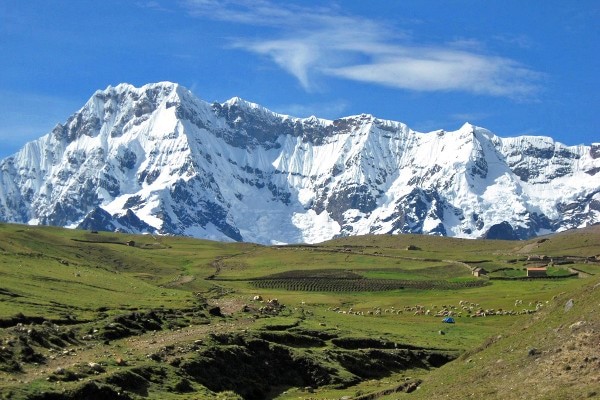
Vilcanota Range and Ausangate Mountain
Lying 100 km / 62 mi south of Cusco is the impressive Cordillera Vilcanota. The mountain range has several peaks over 6,000 meters (19,685 feet) high, including the sacred Ausangate peak (6,372m / 20,906ft). Ausangate is the highest mountain in the Cusco region and the 5th highest mountain in Peru.
Ausangate mountain itself is considered a holy mountain (or mountain spirit) by locals. Since pre-Inca times (see Inca trail history), the mountain has been a place of worship.
The mountain is also notable for the Qoyllur Rit’I Festival at the end of May. This is held on the opposite side of the Cordillera Vilcanota, in the Sinakara Valley. The festival draws over 10,000 pilgrims each year. This deity of Cusco is celebrated through traditions and offerings.
Looking for a day tour? Here are my 5 favourite day tours around Cusco:
- Rainbow Mountain day trip (with meals)
- Moray and Salt Mines Quad Bike Tour
- Sacred Valley day tour
- Humantay Lake day tour
- Machu Picchu and Huayna Picchu entrance tickets
See more Cusco day trips.
Where Do You Sleep On The Ausangate Trek?
Camping is usually the norm for sleeping and resting on this route. If you book with a tour company, porters will pack and carry the tents and camp equipment for you.
You may also like: Best Inca Trail companies and Best Machu Picchu tours
Please Note: There are no established campsites on the Ausangate trek. Tents are set up along the route, and often alongside a turquoise lake.
Some companies also offer Ausangate trek as a ‘lodge’ trek in which you will stay in very basic huts along the route.
Where to stay? Here are 5 of my favourite accommodation options in Cusco:
- Sonesta Hotel (great 4 star hotel)
- Antigua Casona San Blas
- El Mariscal Cusco (very good value)
- Hotel Paradis (good 3 star hotel)
- Quechua Hostal Recoleta (cheap and cheerful)
See more Cusco accommodation options.
Horse Riding On The Ausangate Trek
The Ausangate trek is one of the few treks in Peru that offers the option to ride a horse along the route. Operators will provide the horses and extra horses will also be brought to carry your gear and equipment.
Certain sections of the trek are so steep that you’ll need to get off and walk beside your horse. If you are not a confident rider (or don’t like horses) then trekking-only tours on foot are a more suitable option.
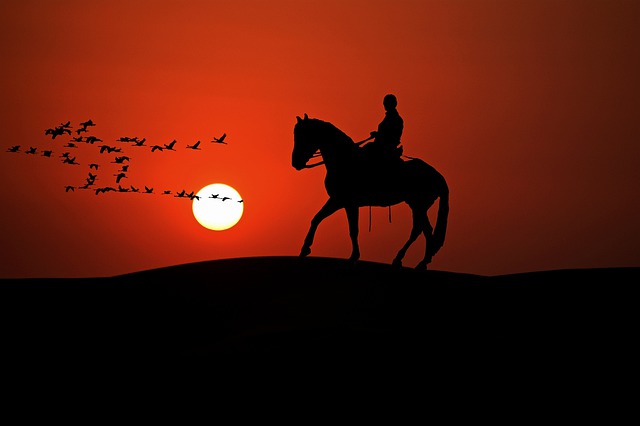
Ausangate Trek Scenery And Wildlife
The Ausangate trail has some of the most stunning scenery of all of Peru’s hiking areas. Mossy passes and glaciers add to the mystical feel of this route. You will pass small villages where time has stood still.
The trek offers an array of wildlife including soaring condors and vicunas (a wild relative of the alpaca). Look out for chinchillas scrambling between the boulders. And, if you are extremely lucky, you may even catch a glimpse of a bobcat or puma.
You’ll also have the chance to bathe in hot springs and view the trek’s signature Rainbow mountains! These colorful sandstone slopes are some of the coolest things you’ll see in Peru.
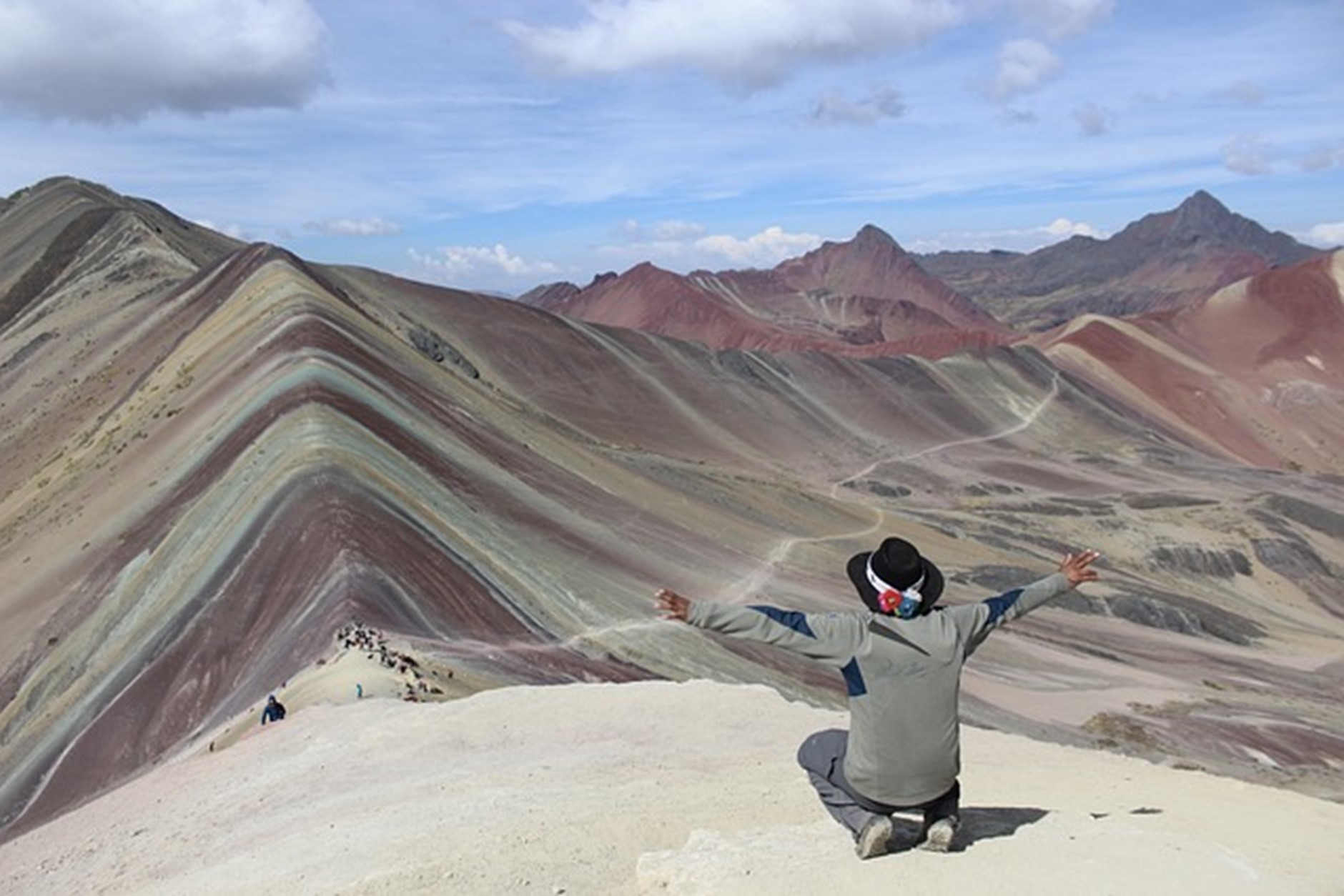
How Difficult Is The Ausangate Trek?
With several mountain passes over 5,000 meters (16,404 feet) high, the Ausangate Trek is relatively difficult. It is best to have experience with multi-day hikes in alpine conditions to do this trek.
As such, the Ausangate trail is classified as a Grade C trek: fairly long and many sections are at high altitudes.
You’ll need a good level of fitness and stamina as you’ll be trekking over many undulating sections. In addition, the elevation changes significantly over a short space of time.
The trail itself is fairly good and well-defined, but the weather can be unpredictable in these mountains. It's not uncommon to experience blizzard conditions in these parts. If you don’t deal well with cold conditions, then this trek isn’t for you.
If you are going by horseback, you’ll most likely be riding for much of the flat sections. Your operator should allow good time for acclimatization to prevent hikers from getting altitude sickness on the higher slopes.
Please Note: This trek is not suited for first-time trekkers. If you are a strong walker and have completed some moderate treks prior to this, then you should be fine.
As there are several high sections on the trek, I recommend reading up on Acute Mountain Sickness (AMS) and how to diagnose and treat the condition. The important thing is not to rush during your trek - slow and steady is better for descending a steep mountain pass. If you have chosen a good operator, they will take this into account.

Ausangate Trek - Typical 6-Day Route Itinerary
There are several route itineraries options for the Ausangate trek: a 4-day, 5-day, 6-day, and 7-day itinerary. The most popular is the 6-day itinerary which we have laid out in more detail below.
Day 1: Cusco - Tinki - Upis
- Total Hiking distance: 7km / 4.3 miles
Most tours will start in Cusco from where your operator will drive you southeast to Tinki (Tinqui). You’ll most likely stop along the way in Ocongate or Qatca for a drink and to experience the local culture.
The journey to Tinki takes roughly 3.5 hours. From Tinki, the real trekking begins.
You will start trekking through the Vilcanota Valley before steadily climbing upwards through high grasslands. Here, you will get your first glimpse of the Vilcanota range. You will see both Ausangate and Colqe Cruz peaks in the distance.
Next, you will start crossing the Mapacho river. Continue on through local community villages towards the base of Ausangate. You will camp near the thermal baths at Upis which are 4,408m (14,462 ft) high.
Local legend tells of the bath’s medicinal properties. Each year, pilgrims make their way to these healing waters.
Day 2: Upis - Arapa Pass - Puqa Q’ocha Lake
- Total hiking distance: 15km / 9.3 miles
The morning begins with your first mountain pass crossing – Arapa (4,850m / 15,912 ft). It takes about 2 hours to ascend this pass. The views of Ausangate from Arapa pass are stunning, so get your camera ready!
After reaching the pass, you will stop for a light lunch. Next, you will descend into the valley, which will take 40-60 minutes of trekking on a well-trodden gravel trail.
On your descent, you’ll pass the green lake of Puqa Q’ocha (4,556m / 14,948 ft). This is connected by a waterfall to another gorgeous lake - Jatun Puqa Q’ocha. Your camp for the evening is usually beside this lower lake.
From your campsite, you can choose to climb a nearby ridge to view the red-tinged lake of Vino Q’ocha. Each lake in the region is colored differently. This is because of sediment variations in the nearby mountains, which makes for an alluring experience.
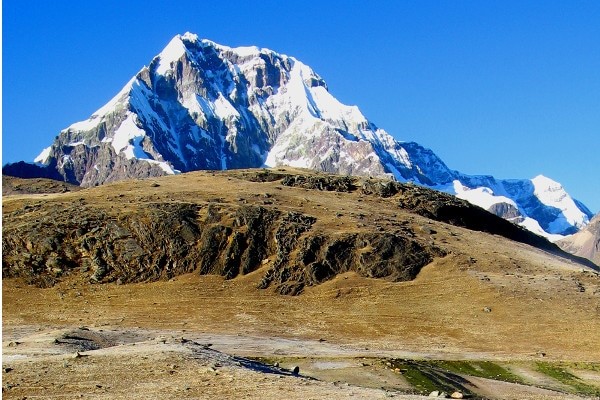
Day 3: Jatun Puqa Q’ocha Lake - Palomani Pass - Chillca
- Total Hiking Distance: 9.5km / 6.8 miles
On day 3 of your trek, you will conquer the highest pass on the trek - the Palomani pass. You will rise early and begin your day passing herds of vicunas, alpacas, and llamas. The looming form of Ausangate watches over you from your left.
It is a 500m (1,640 ft) ascent up the pass. At the top of Palomani pass, you will be 5,051m / 16,571 ft above sea level. The reward for your effort is breathtaking views across the southeast mountain range.
From here, you are able to see the peaks of Mariposa and Caracol in the distance. This is a great location to spot solitary condors and marvel at their enormous size!
After heading back down, you will follow the Jampamayo River through the small village of Jampa. Your campsite will be at Chillca (4,456 m / 14,619 ft).
Please Note: If you are visiting Rainbow Mountain, you will probably camp at Ananta. You should arrive by midday and visit Rainbow Mountain the same afternoon. You can leave your bags at camp and hike to Rainbow Mountain and back. Alternatively, you can go to Rainbow Mountain early on Day 4 of your trek.
Day 4: Chillca - Pampa Jutunpata Valley trek - Lake Q’omercocha
- Total Hiking Distance: 12.5km / 7.8 miles
Day 4 is a slightly easier trek. You will follow the Pampa Jutunpata valley along the shores of Lake Ticllacocha.
The valley is a great place to spot wildlife. Look out for vizcacha, vicuñas, and bobcats. You’ll stop and have lunch before tackling the last of the passes – the Q’ampa pass (5,000m / 16,404 ft).
From the top of the pass, you can see several stunning lakes glimmering in the sunlight. You will then descend down the other side and camp beside the blue-green lake of Q’omercocha (4,704m / 15,433 ft).
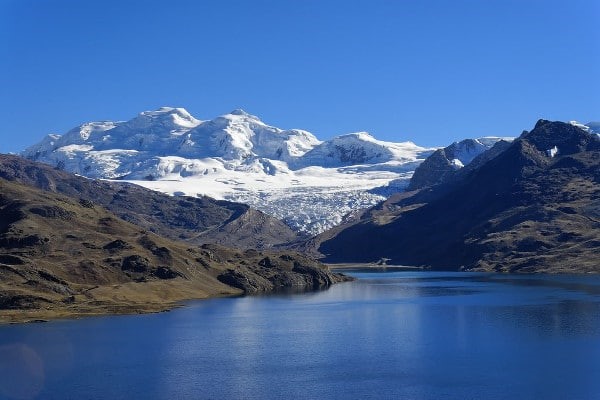
Day 5: Q’omercocha - Pajchanta
- Total hiking distance: 7.5km / 4.6 miles
After breakfast, you will have an easy descent. You will be walking down slope towards the village of Pajchanta (4,010m / 13,156 ft). This takes most hikers approximately 5 hours of walking.
The village is an extremely authentic insight into traditional Peruvian culture where local village people make their living here from herding and farming.
The village is also home to some very picturesque natural thermal pools. Take the opportunity to soak your weary bones in the warm waters.
Some operators will press on for another 3 hours to the town of Tinki; however, most camp at Pajchanta for the night.
Day 6: Pajchanta - Tinki
- Total hiking distance: 4.8km / 3 miles
In the morning, you will make your final trek back to Tinki. Say goodbye to your guide and pack up your horses (and say thank you with a nice tip). The bus will collect you here for your trip back to Cusco.
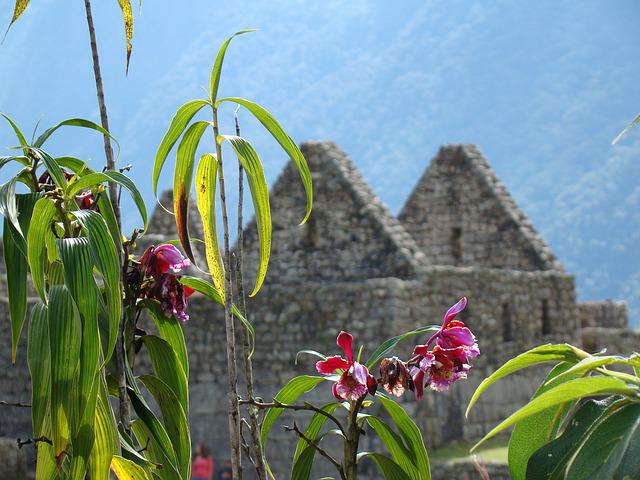
9 Day Ausangate Trek: Machu Picchu Extension
Occasionally, a tour operator will offer the Ausangate trek in conjunction with a visit to the ancient citadel of Machu Picchu. If you have a little more time (and money) on your hands and want to see the magnificent ruins, then this is a great option.
The itinerary is almost identical to the one above until you get to the final day. Instead of trekking from Pajchanta to Tinki, you will trek from Pajchanta to Laguna Armaccocha instead. See below for more details.
Day 6: Pajchanta - Laguna Armaccocha
You’ll have the chance once again to bathe in the thermal pools in the morning. Afterward, you will set off from your campsite at Pajchanta.
The trek is on a well-trodden route through remote highlands. You’ll likely see more herds of alpacas and llamas here.
The walking distance is a fairly short one. You should arrive early in the afternoon at the beautiful Laguna Armaccocha (4,665m / 15,305 ft).
The snow-capped Nevado Collque Cruz peak sits directly above you, making this a lovely place to camp.
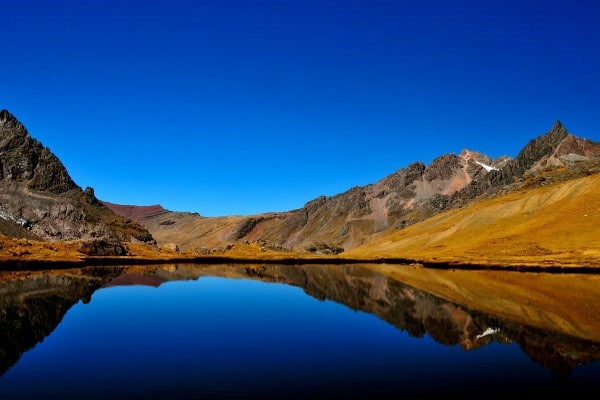
Lake Singrenacchocha
Day 7: Lake Armacoccha - lookout point - Lake Singrenacchocha
After breakfast, you will continue trekking northeast. You will climb a steep shoulder and cross a narrow pass to reach an incredible lookout point (4,940 meters / 16,207 feet).
From the lookout, you get a gorgeous 360-degree view of the surrounding mountains. Several of the peaks are above 6,000 meters (19,685 feet)! From here, you will descend down to the shores of lake Singrenacchocha (4560m / 14,961 ft). This is where you will camp for the night.
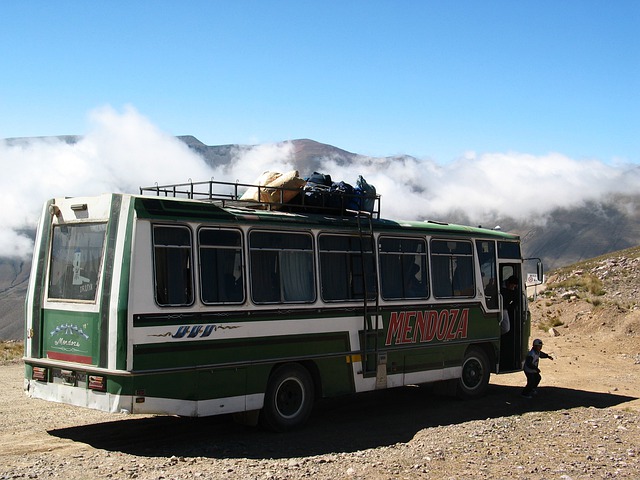
Day 8: Lake Singrenacchocha - Mallma - Cusco - Ollantaytambo
Day 8 is the final day of trekking. You will hike along the lake shore to the rivers that feed it. Follow the river as it gently descends to Mallma at 4,230 meters / 13,878 feet.
In Mallma, you will have lunch before boarding a bus that will take you back to Cusco. From there, you will head to Ollantaytambo where you will check into a hotel.
Day 9: Train to Aguanas Calientes
From Ollantaytambo, you can take a 90-minute train to Aguas Calientes. We have detailed information on things to do at Machu Picchu.
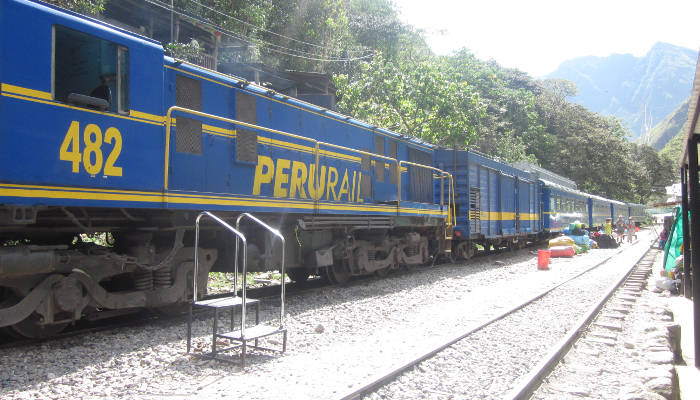
Rainbow Mountain Add-On To The Ausangate Trek
A visit to Rainbow Mountain will add an additional day to your Itinerary. Most companies hike to Ananta camp on Day 3. From here, you will trek to Rainbow Mountain in the afternoon or the following morning.
Expect to see loads of tourists and decorated alpacas at this famous Peruvian landmark. There are usually long queues to get a ‘classic shot’ of the colorful slope in the background.
Please Note: If you are looking for a more authentic trail, you may want to skip this extension. You can still visit Rainbow Mountain on a day tour from Cusco. It is fairly easy, and arguably better, to take a bus to visit Rainbow Mountain. It is recommended that you travel slightly later in the morning (around 8 am) to reach the mountain just after the crowds have thinned out.
Can I Hike The Ausangate Trek Without A Guide?
It is possible to hike Ausangate without a guide. This is a lot more adventurous and also works out much cheaper. However, due to its difficulty and remote setting, I don't recommend this option for inexperienced trekkers.
Only about 5% of hikers on the Ausangate Trek do it solo. These hikers have the right equipment and experience trekking at high altitudes.
If you are planning on hiking Ausangate without a guide, you will need to be completely self-reliant. It is difficult to find accommodation along the way. This means you need to carry all of your own camping gear and food.
A guided trek is a better option for most people. Ausangate is one of the less popular hikes around Cusco. This means group sizes are usually small if not completely private.
Another benefit of booking with a company is that you don’t have to worry about carrying food or preparing meals. You can focus on enjoying the trail.

What Does It Cost To Hike The Ausangate Trek?
Ausangate Trek Cost With A Company
Prices for the Ausangate trek vary greatly between companies. This is true for all the trekking tours from Cusco.
Generally, you can expect to pay between $450-$850 for this trail. This includes guides, transport, horses, and camping gear. Chefs and all meals during the trek will also be included in the price.
Please Note: You usually need to pay extra for sleeping bag rental. Sometimes, the first and final meals are not included. Be sure to check with your tour company about what’s included in your tour package as well as extra expenses.
Unguided Ausangate Trek Cost
Hiking the Ausangate Trek without using a company works out significantly cheaper. There are no support crew fees. Basically, you will only be paying for transport, food, and equipment rental.
Please Note: This is only an approximate estimate. You may need to hire additional equipment and prices vary between rental agencies. I recommend taking a day or two to shop around and adjust your budget.
Doing the trail independently is much more planning intensive. However, this can be rewarding if you are a seasoned multi-day trekker.
Here is a breakdown of expenses on the Ausangate Trek (per person):
- Bus from Cusco to Tique: 10 soles ($3) each way.
- Tique Park Entrance Fee: 10 soles ($3).
- Food Supplies (including gas for cooking): 100-150 soles ($30-$45).
- Camping Gear (tent, sleeping bag, sleeping mat, and cooking set): approximately 40 soles per day.
- Try to budget for about 300 soles ($80) for 6-7 days.
- Total Ausangate Cost Per Person: 470 soles (about $120).
Map and Guidebooks
The map below is the best online map I could find for the Ausangate trek. Please note that the map is not to scale. The trail marked on the map is only representative of the general direction of the route.
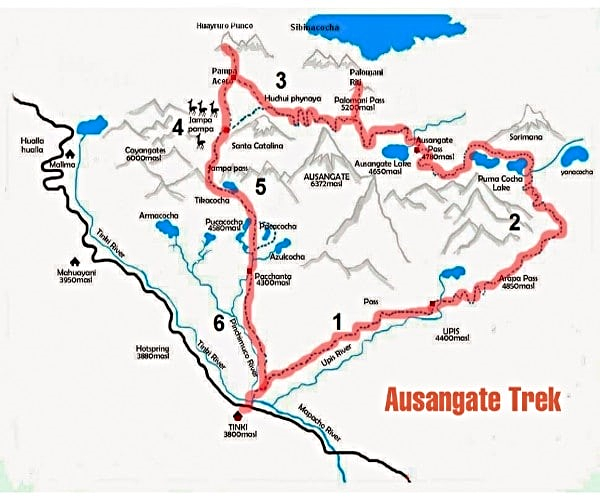
There is a serious lack of hand-held maps for the Ausangate trek. Your best option is to buy the Lonely Planet Trekking in the Central Andes guidebook map for more detailed maps of the region.
Although not as detailed as many maps, the map of the Cordillera Vilcanota above is decent enough. With maps like this, experienced trekkers should be able to find their way without a guide.
Please Note: Planning on hiking the Ausangate solo? I’d advise being a little sneaky while in Cusco. Find out which tour offices sell this trek and pay them a visit. If you tell them you are interested in this trail, they will usually describe the route and may even give you a map. Just don’t say you intend on trekking unguided!
Best time to do the Ausangate Trek
Like most treks in the region, the best time to do the Ausangate trek is in the dry months. This is between May and September which coincides with the busy season.
Unlike other popular Machu Picchu routes, the Ausangate trek is very quiet, even in peak season.
Seasonal shoulder months are April and October. During this time, there is a mix of rain and sunshine. The weather is mostly pleasant, and it is possible to hike the Ausangate trek.
At these high elevations, you’ll have to contend with freezing nights though. This is also true for the dry season which is Peruvian wintertime. The Ausangate trek is best avoided in the wetter colder season between November and February due to snow at high altitudes.
In the dry months, daytime temperatures are usually mild and visibility is high. You will want to wear layers, especially for colder nights. Please see our packing list below for suggestions.
You may also like: best time to hike to Machu Picchu and Inca trail weather
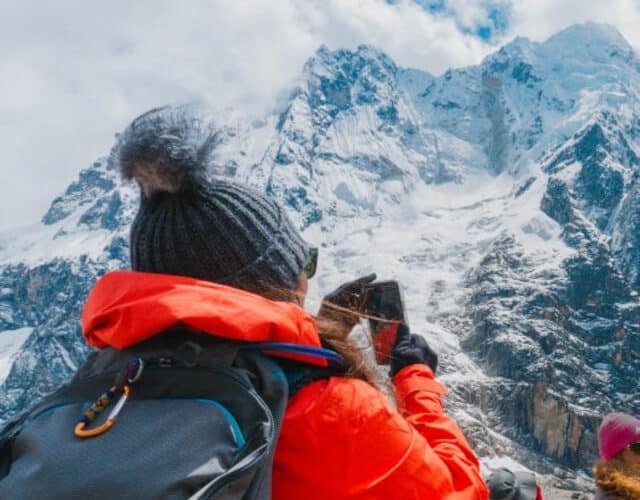
Acclimatization and Altitude Sickness On The Ausangate Trek
The Ausangate trek is one of the highest altitude treks in Peru. Obviously, this means certain altitude sickness risks. Acclimatization is the key factor in ensuring you have a safe and enjoyable trek.
We suggest that you take a minute to read our detailed article on altitude sickness and acclimatization.
Ausangate Trek Packing List
The equipment and packing list for the Ausangate trek is similar to that for other Cusco hikes.
For more insights, see our packing list for the Inca Trail. You will need more changes of clothes as the Ausangate trek is longer. It is also worth investing in thermal undergarments too for an added layer of protection.
If you are hiking independently, make sure the gear you take is suitable for sub-zero temperatures. In this case, you will also need to take cooking equipment and food. Items like dried fruit, instant pasta, packet soup, and instant oatmeal are lightweight and convenient food choices.
Do You Need Trekking Insurance for the Ausangate Trail?
Insurance for any multi-day trek in a foreign country is a must. Many operators will require you to carry sufficient travel insurance for your trek.
The Ausangate trek reaches passes higher than 5, 000m. In this instance, you will need to make sure your insurance covers you for high-altitude hiking. I have reviewed a number of travel insurance providers and the most affordable and best is Rise & Shield.
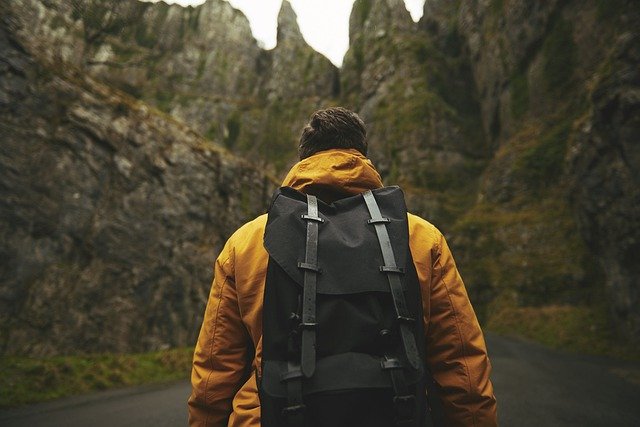
Conclusion
I hope you have enjoyed this article. If you have any further questions about the Ausangate trek, please leave a comment below. We’ll get back to you within 24 hours.
You might want to bookmark this page for future reference. Feel free to share my article with friends or link to your blog. We also always appreciate a shout-out on social media. Happy trekking!
Tags: Ausangate trek, Ausangate trek Peru, Ausangate trail, Ausangate trek to Machu Picchu
References: 1. Contemporary Nomad
